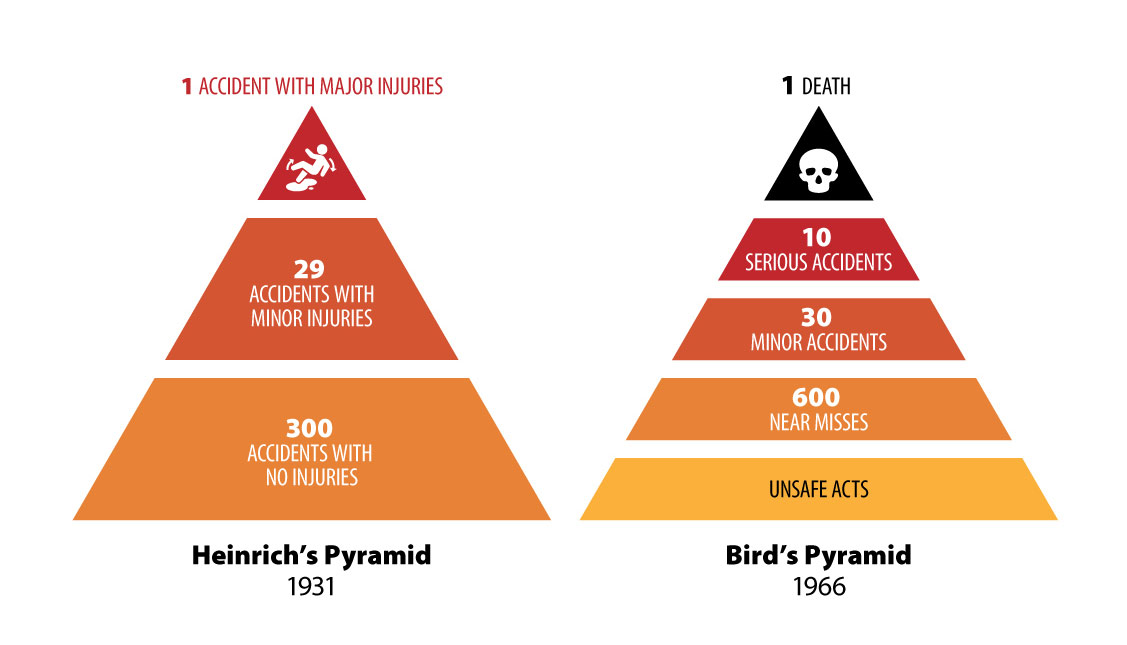Heinrich's Pyramid - Does It Hold Up 90 Years Later?

Herbert William Heinrich was an assistant superintendent of an insurance company and back in 1931 he commenced a study of more than 75,000 industrial accidents. The result of this work was published in Industrial Accident Prevention: A Scientific Approach. Heinrich’s resultant theory is often depicted in a pyramid or a triangle. It is based upon the need to eliminate non-injury incidents in order to eliminate minor and serious injuries. By focusing on preventing the 300 incidents that occur for every serious injury we could reach the goal of injury elimination.
This theory has been modified over the years, most notably by Frank E. Bird in 1966. His analysis was based on over 1.7 million accident reports from over 300 companies. His results are depicted similarly, but with 600 incidents at the base and a single death at the top.

The validity of these numbers has been challenged many times. The focus also tends to be on individual behaviors as injury causes. W. Edwards Deming, a noted engineer, professor, and management consultant, theorized that poor management systems were much more culpable in injury causation.
Regardless of how accurate the numbers might be, or what the root causes of any given incident might be, the overall approach to workplace safety should always have emphasis on reporting of all near-misses and unsafe behaviors. If we don’t have a clear picture of how many incidents are occurring, we won’t know where to focus and what the mitigation strategies should be. It’s easy to be reactive when injuries occur, but far better to be proactive and find these incidents before an injury results.
For example, a large organization may have great programs designed to prevent chemical spills, fires, or falls from height. These are clearly all serious safety issues and do deserve attention. But if that’s the only focus, other serious hazards might go unaddressed. Slips and falls in the parking lot could bring just as much pain and chaos to a business, and if previous incidents were not reported the risk might not be acted upon until the injuries start adding up. If near-misses, or unsafe acts, are not investigated or corrected the only preventive measure in place may just be luck. Since everyone’s luck runs out eventually this isn’t the best strategy.
I had this discussion with a safety committee a few years ago. The meeting was held in a conference room with large windows overlooking the loading dock area. The committee was struggling with the concept of near-misses and what they should be acting upon. As I was about to answer their questions I looked outside and a saw a forklift driver start to unload a flatbed trailer. He jumped out of the forklift and made a quick adjustment, then jumped back in and continued. He didn’t ever reach for the seat belt. This became a great example of a near-miss or an unsafe behavior that I was able to share with the committee… and it was right in front of them. No injury or damage occurred, yet that operator was engaged in an undesirable behavior that needed to be addressed. Stop those behaviors and you stop future injuries from that cause.
Safety culture depends upon strong leadership and engaged management at all levels. Unsafe behaviors are eliminated through employee support, education, training, accountability, and consistency. If a worker takes a shortcut it’s probably because he wants to complete the job quickly, has never been told to do otherwise, and/or has never been given progressive coaching. Stopping the “minor” issues will help create a culture of injury prevention and improved productivity.
In Heinrich’s conclusions we find an eloquent quote that I could never improve upon: “When a situation exists that creates loss of life, injury and suffering; when it costs a king's ransom annually, when its cure has been demonstrated to be practical; and when all are agreed that something can and should be done about it, it is time to stop talking, roll up the sleeves and go to work.”
Be safe out there and get to work!

